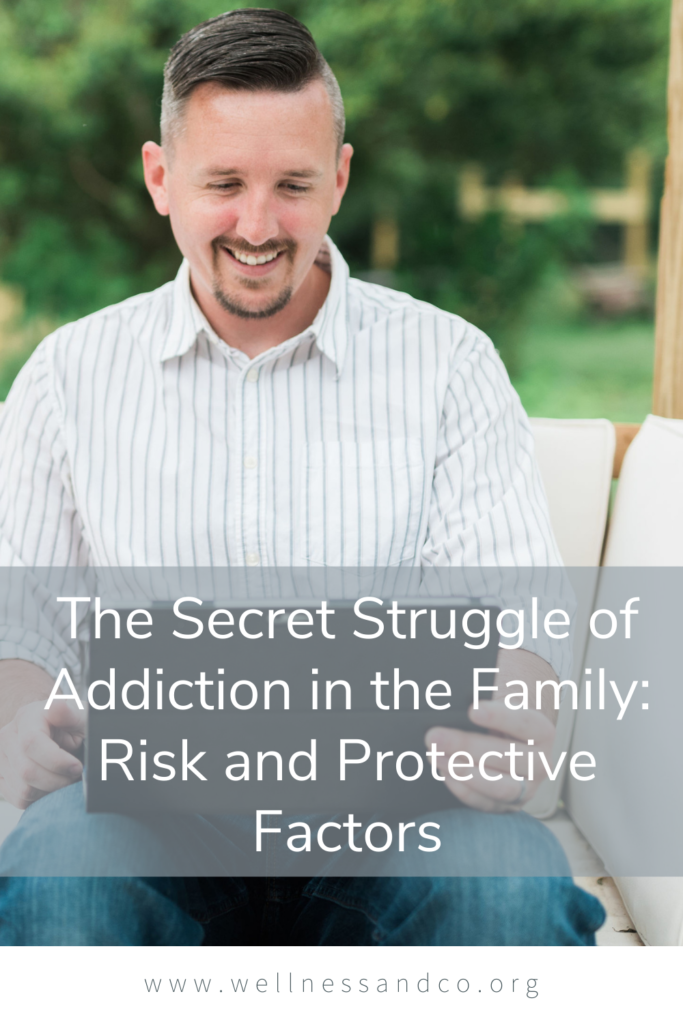Follow
Wellness & Co.
Hi, I'm Dr. K, Wellness & Co. is a growing therapy/coaching practice and educational hub for prospective clients based in Maryland and virtual clients all over the world!
Hi, I'm Dr. K
free guide
e -books
e -course
The Secret Struggle of Addiction in the Family: Risk and Protective Factors
December 14, 2020
by Mike Gillis, LCSW-C
Welcome back! This week we are going to be discussing some of the factors that have been shown to put adolescents and young adults at risk for drug and alcohol abuse as well as things that you, the family, can do to protect against those risks. If you missed my last blog post discussing the crucial step of being honest about what’s going on at home, please take some time to catch up!

Are You Saying It’s My Fault?!?
If I’m being honest with everyone for a minute, I’m not a perfect parent! I know, shocking right? We all have been there, where we look back and wish we would have done things differently. I’ve talked to countless parents and family members that, in hindsight have said, “If only I would have done (insert every normal misstep ever made) different/better, they wouldn’t have started using to begin with.”
Reality is, even if we do everything right as parents or family members (which we won’t), some factors are out of our control. Risk factors are not guarantees of future outcomes so, let’s be honest with ourselves about which factors may be present but not beat ourselves up if they are. I won’t be able to talk about every possible risk factor but I will try and talk about the most significant.
What Puts my Loved Ones at Risk?
One of the most well documented risk factors is a family history of drug or alcohol abuse. This has been shown to genetically prime an individual who tries substances to be more likely to become addicted. This link has been shown to skip generations, so just because a parent doesn’t have an addiction, it doesn’t mean it hasn’t been past down from a grandparent.
Some early childhood behaviors which have been linked to use include: (1) early aggressive behaviors, (2) mental health issues, and (3) struggles socially and academically in school.
A history of abuse (verbal, sexual and physical) is also shown to be linked to an increase risk of using substances. Finally, low family involvement, accountability, and boundaries can lead to an environment that increase risk of use and abuse. Even though family involvement is the factor that we have the most direct control of, there are no simple solutions, as any family member reading this already knows.
What the Hell am I Supposed To Do?
The scary truth is there is nothing we can do as family to 100% prevent every bad thing possibly from happening to our loved ones.
That being said, fostering a family environment that is accepting, engaged and supportive is one of the best protective factors there is. There is certainly a balance between being an overbearing family and one that has loose boundaries.
While adolescents and young adults need a sense of independence, knowing who your family is spending their time with, having expectations of where they are and when they will be home, following up with discussions and enforcing established boundaries are all within the realm of healthy involvement. It is so cliche but open communication goes such a long way in preparing adolescents and young adults for the peer pressures that they will almost certainly face at some point.
Outside of the home, an individuals level of involvement in school activities as well as their access to mental health support have direct links to likelihood of drug abuse.
Ok…I Know That Was A lot
In many ways I feel like I could talk about each of these factors so much more. And, it’s fine if this blog sparked more questions than it answered. That means you are thinking about things from an honest perspective.
Please know: this is such a complex topic and I can’t possibly cover everything in this post but would love to set aside some time to discuss anything that came up for you while reading this. I’m just an email or phone call away – this is my bread and butter, let’s get you the healing and hope you’ve been desiring for a long time.
Up Next: Signs of Use
Dr. K started Wellness & Co. with the desire to provide top-notch therapy to our local community. Now, Wellness & Co., has therapists, coaches, tutors, and professional organizers – all to provide wrap-around, boutique style care to our clients. Dr. K specializes in couples therapy, healing from infidelity, and supporting individuals through relational transitions.
Leave a Reply Cancel reply
CONTACT
Start Here
BLOG
OUR TEAM
SHOP
ABOUT
©2025 Wellness & Co. | All Rights Reserved | Design by EverMint Design Studio
BACK TO TOP
connect with us on instagram
